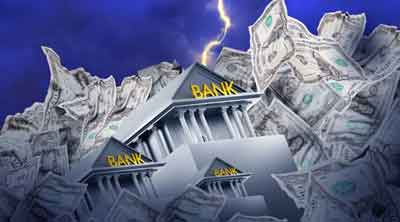It’s Turtles All the Way Down
Brian Maher
 Twentieth-century British philosopher Bertrand Russell once gave a public lecture on astronomy. Twentieth-century British philosopher Bertrand Russell once gave a public lecture on astronomy.
An attendee — supposedly — claimed that Earth was not situated in space, as this Russell fellow argued…
This attendee claimed instead that Earth rested upon the back of a monstrous turtle.
Russell asked this individual what particular solidity the turtle was standing upon, what structure held it up.
The attendee replied there was no solidity whatsoever. No structure held it up. It was “turtles all the way down.”
In today’s byzantine, baffling and beguiling monetary system, it is not turtles all the way down.
It is instead credit all the way down.
Credit supports the entire monetary universe upon its broad yet delicate shoulders.
Money Is Credit, Credit Is Money
The dictionary defines credit this way:
The ability of a customer to obtain goods or services before payment, based on the trust that payment will be made in the future.
Yet therein lies a vast tale…
The dictionary refers to payment. But payment in what? What precisely constitutes payment in this unanchored and goldless age?
The answer — ultimately — is credit.
Credit and debt are twins. One man’s credit is another man’s debt. Credit is a debt disguised.
You may execute your payment in dollars. Yet the dollar itself is a manifestation of credit. All dollars are borrowed into existence.
In words other… dollar payment itself is an instrument of credit.
Thus we embark upon what philosophical men label a “tautology.”
That is: “a phrase or expression in which the same thing is said twice in different words.”
One dollar equals 100 cents. Yet what is a cent without reference to a dollar? Here you have embarked upon a tautology.
Without Debt There Is No Money
On Sept. 30, 1941, Federal Reserve Chairman Marriner Eccles sat in front of the House Committee on Banking and Currency.
Committee chairman Wright Patman asked this fellow where the Federal Reserve had acquired the monies to purchase $2 billion in government bonds. Their exchange ran this way:
ECCLES: We created it.
PATMAN: Out of what?
ECCLES: Out of the right to issue credit money.
PATMAN: And there is nothing behind it, is there, except our government’s credit?
ECCLES: That is what our money system is. If there were no debts in our monetary system, there wouldn’t be any money.
Now you have the flavor of it. It is credit all the way down.
Is it any wonder then that today’s financial system is vulnerable to banking frights of the sort presently on display?
It is erected not even upon the shifting foundations of beach sand — but upon foundations of air.
It lacks all anchoring in material realities. Anchoring in, for example… gold.
Credit Cannot Be Money
Economist Alasdair Macleod:
Under a gold standard, incorporeal property took its value from a material property. Under today’s fiat dollar standard, all forms of incorporeal property take their value from another incorporeal property, banknotes, which are a central bank’s liability. Credit is only valued in another credit, an arrangement which is inherently unstable, irrespective of changes in its quantity.
Again, it is credit all the way down. Yet since ancient eras, adds Mr. Macleod:
It was made clear that the value of credit was based on money, which was physical gold and silver. Without the value-link to gold or silver, there was no means of valuing credit, and all promises, which are the essence of credit, require to be valued… Even though it doesn’t feature as such in modern economies and economics, gold still remains the principal corporeal form of medium of exchange.
That is, credit cannot be valued by reference to credit. Credit must have anchoring in, it must derive its existence from, authentic money. More:
Debt and credit must take its value from something… In history, the value-anchor was always a corporeal entity such as gold. Instead, today it is anchored to another incorporeal asset — central bank credit, or banknotes. In other words, the entire structure of national credit hinges on the government’s credibility as issuer of currency obligations.
In conclusion:
The only solution to prevent fiat currencies from collapsing entirely is to officially recognize and reintroduce gold as money, making it the standard against which all credit is valued.
Governments Hate Gold
Yet this Macleod fellow is no fantasist. He understands well that no government will voluntarily place its wrists in golden handcuffs. No government will voluntarily relax its vise grip upon the manufacture and distribution of credit.
As well expect the devil to gulp holy water. Yet does it diminish the case?
As we have argued before:
Gold moves at its own leisurely pace. The greater good is beyond its care. It lacks all human compassion.
Gold is as civically minded as a cat.
And it turns from the sound of trumpets. “You go over there,” gold says. “I’ll stay here.”
As wrote our co-founders Bill Bonner and Addison Wiggin in Empire of Debt:
The trouble with gold is that it turns its back on world improvers, empire builders and do-gooders. The nice thing about gold is that it is so unresponsive. It neither laughs nor applauds.
That is precisely why gold could not endure…
Only a debt-backed system of paper money could finance the great wars, the social improvements and the fevered dreams of the 20th century.
This money is ideal for public service.
It is civic-minded. It has a heart. It follows orders.
Whatever war, whatever boondoggle, whatever swindle it is ordered to get behind… it will get behind.
Fiat money — credit money, debt-backed money — willingly sacrifices its value for the greater good.
The Gold Standard of Money
In our estimation gold is perhaps the ideal money, money par excellence — if you will forgive the expression, the gold standard of money.
It cannot be conjured at a stroke.
Money must be rare. Rocks cannot be money — for example. Nor can dirt.
Yet there must be enough money to “go around.”
Gold is rare. But there is enough to go around. Hence it meets money’s strict conditions.
Gold is also durable. Gold mined thousands of years ago lives yet, fresh as a sprig, no wrinkles, no sags.
And unlike gems or diamonds, gold is divisible. It can be fashioned into bars or coins as requirements dictate.
Meantime, money must be a store of value. Once again gold is sufficient to needs. Gold maintains its value across centuries, across millennia.
In brief: Gold is everything credit is not.
It is time the world once again gives credit where it is due — gold.

Brian Maher is the Daily Reckoning’s Managing Editor. Before signing on to Agora Financial, he was an independent researcher and writer who covered economics, politics and international affairs. His work has appeared in the Asia Times and other news outlets around the world. He holds a Master’s degree in Defense & Strategic Studies.
dailyreckoning.com
| 

